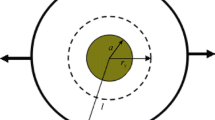Abstract
A two-dimensional finite element model was developed to study effects of particle diameter, mechanical properties of the fiber and matrix materials and loading conditions (Mode 1 and Mixed-Mode). A theoretical model was proposed to calculate the stress intensity factor for an interface crack in Particle-Reinforced Metal–Matrix Composites. The displacement Correlation Method was used to calculate the stress intensity factors K 1 and K 2. In the present model the fiber and matrix materials were modeled in linear elastic conditions. The interface crack was considered between the fiber and matrix, without the presence of the interphase. Obtained results show that the key role on the stress intensity factors played by the relative elastic properties of the fiber and matrix. The results also show that K 1 and absolute K 2 values increase for both Mode 1 and mixed-mode loading condition once Young’s modulus of the fiber material increases. The values of K 1 and K 2 stress intensity factors decrease when the fiber volume fraction increases for Mode 1 loading.









Similar content being viewed by others
References
Aghdam, M.M., Falahatgar, S.R.: Micromechanical modeling of interface damage of metal matrix composites subjected to transverse loading. Compos. Struct. 66, 415–420 (2004)
Aslantas, K.: A different approach for calculation of stress intensity factors in continuous fiber reinforced metal matrix composites. Int. J. Solids Struct. 40, 7475–7481 (2003)
Aslantas, K., Tasgetiren, S.: Debonding between coating and substrate due to rolling–sliding contact. Mater. Des. 23, 571–576 (2002)
Chan, S.K., Tuba, I.S., Wilson, W.K.: On the finite element method in linear fracture mechanics. Eng. Fract. Mech. 2, 1–17 (1970)
Chen, X., Liu, Y.: Multiple-cell modelling of fiber reinforced composites with the presence of interphases using the boundary element method. Comput. Mater. Sci. 21, 86–94 (2001)
Cisilino, A.P., Ortiz, J.E.: Three-dimensional boundary element assessment of a fiber/matrix interface crack under transverse loading. Comput. Struct. 83, 856–869 (2005)
Erdogan, F., Sih, G.C.: On the crack extension in plates under plane loading and transverse shear. J. Basic Eng. 85, 519–527 (1963)
Jincheng, W., Gencang, Y.: The energy dissipation of particle-reinforced metal-matrix composite with ductile interphase. Mater. Sci. Eng. A 303, 77–81 (2001)
Ju, J.W., Lee, H.K.: A micromechanical damage model for effective elastoplastic behaviour of partially debonded ductile matrix composites. Int. J. Solids Struct. 38, 6307–6332 (2001)
Legarth, B.N., Kuroda, M.: Particle debonding using different yield criteria. Eur. J. Mech. A/Solids 23, 737–751 (2004)
Liu, Y.F., Kagawa, Y.: The energy release rate for an interfacial debond crack in a fiber pull-out model. Compos. Sci. Technol. 60, 167–171 (2000)
Liu, Y., Xu, N.: Modeling of interface cracks in fiber-reinforced composites with the presence of interphases using the boundary element method. Mech. Mater. 32, 769–783 (2000)
Meguid, S.A., Shagal, G., Paskaramoorthy, R.: On the local elastic–plastic behaviour of the interface in titanium/silicon carbide composites. Composites: Part A 33, 1629–1640 (2002)
Meguid, S.A., Sun, Y.: On the tensile and shear strength of nano-reinforced composite interfaces. Mater. Des. 25, 289–296 (2004)
Meguid, S.A., Zhao, X.: The interface crack problem of bonded piezoelectric and elastic half-space under transient electromechanical loads. J. Appl. Mech. 69(3), 244–253 (2002)
Mishnaevsky, L., Derrien, K., Baptiste, D.: Effect of microstructure of particle reinforced composites on the damage evolution: probabilistic and numerical analysis. Compos. Sci. Technol. 64, 1805–1818 (2004)
Rice, J.R.: Elastic fracture mechanics concepts for interfacial cracks. J. Appl. Mech. 55, 98–103 (1988)
Sun, L.Z., Ju, J.W., Liu, H.T.: Elastoplastic modelling of metal matrix composites with evolutionary particle debonding. Mech. Mater. 35, 559–569 (2003)
Tan, C.L., Gao, Y.L.: Treatment of bimaterial interface crack problems using the boundary element method. Eng. Fract. Mech. 36, 919–932 (1990)
Zhong, Z., Meguid, S.A.: On the eigenstrain problem of a spherical inclusion with an imperfectly bonded interface. ASME J. Appl. Mech. 63, 877–883 (1996)
Author information
Authors and Affiliations
Corresponding author
Rights and permissions
About this article
Cite this article
Aslantaş, K., Ergun, E. & Tasgetiren, S. A numerical model for calculation of stress intensity factors in particle-reinforced metal–matrix composites. Int J Mech Mater Des 3, 201–208 (2006). https://doi.org/10.1007/s10999-007-9023-5
Received:
Accepted:
Published:
Issue Date:
DOI: https://doi.org/10.1007/s10999-007-9023-5




